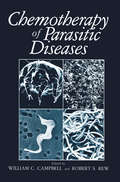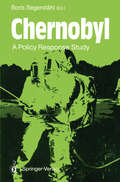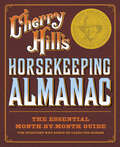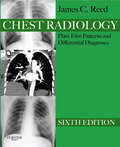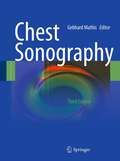- Table View
- List View
Chemotherapy in Psychiatry: Pharmacologic Basis of Treatments for Major Mental Illness
by Ross J. BaldessariniUse of psychotropic drugs has come to dominate clinical practice in psychiatry worldwide—perhaps owing largely to perceived simplicity, ease of use, and apparent efficiency, as well as apparent cost-effectiveness of such treatments. Nevertheless, medicinal treatments for patients with psychiatric disorders are but one component of comprehensive clinical care of complex human problems. Extensively updated since its second edition in 1985, Chemotherapy in Psychiatry, Third Edition, again addresses basic aspects of modern psychopharmacology and clinical applications of drugs used in the treatment of major psychiatric disorders, with major emphasis on psychotic, bipolar, and depressive disorders. The presentation covers descriptions of the main classes of psychotropic drugs, selected information concerning their known action mechanisms and metabolic disposition, and their clinical applications for acute illnesses and to prevent recurrences and long-term morbidity. Also covered are limitations and adverse effects of each type of agent, with emphasis on the fact that all psychotropic medicines have adverse effects that range from annoying to potentially lethal. Chemotherapy in Psychiatry, Third Edition, outlines the need to balance benefits and risks at the level of individual persons. Authoritative, and an important contribution to the literature, Chemotherapy in Psychiatry, Third Edition is an invaluable resource for physicians, scientists, trainees, and policymakers.
Chemotherapy of Fungal Diseases (Handbook of Experimental Pharmacology #96)
by D. Armstrong F. T. Boyle M. Debono B. Dupont S. C. Eardley O. P. Flint R. S. Gordee J. R. Graybill H. Hänel T. C. Jones D. Kerridge A. Lambert D. Loebenberg P. A. Pizzo A. Polak W. Ritter M. M. Roberts W. R. Robertson J. F. Ryley H. J. Schmitt J. D. Sobel J. J. Stern A. M. Sugar M. H. Tarbit H. Vanden Bossche V. V. Villars T. J. Walsh R. G. Wilson M. ZaugFungal diseases have been with us from antiquity; interest in the chemo therapy of fungal disease has exploded in the past decade. To plan and pro duce a book on the topic of antifungal chemotherapy has come as a personal challenge - and something of an eye-opener - towards the end of my re search career. A landmark publication which still merits reading is Antifungal Chemotherapy (John Wiley & Sons, Chichester, UK), edited by David Speller, which appeared in 1980. However, the fact that ketoconazole, the first of the modern, orally active, wide-spectrum antifungals, attracted no more than two sentences in it indicates just how far we have come in the 1980s. A steady stream of original papers and a number of conference proceedings have chronicled this progress in drug research; outstanding among the latter are the proceedings of an international telesymposium, entitled Recent Trends in the Discovery, Development and Evaluation of Antifungal Agents, edited by Robert Fromtling (J.R. Prous, Barcelona, 1987) and volume 544 of the Annals of the New York Academy of Sciences, entitled Antifungal Drugs, edited by Vassil St. Georgiev, and containing papers and posters presented at a most enjoyable 3-day conference held at Garden City, New York, in the autumn of 1987.
Chemotherapy of Gastrointestinal Helminths (Handbook of Experimental Pharmacology #77)
by J. H. Arundel J. H. Boersema C.F.A. Bruyning J. H. Cross A. Davis A. De Muynck P. G. Janssens W. S. Kammerer J. F. Michel M. H. Mirck M. D. Rickard F. Rochette M.M.H. Sewell H. Vanden BosscheParasitic diseases are the most widespread of all the major diseases, currently 9 affecting about 3 x 10 people and innumerable domestic animals. There is no doubt that among these parasitic diseases, the helminthic infections of the gastrointestinal tract are about the most important because of their global distribution, their high prevalence, their effects on the nutritional status of men and animals, their effects on the physical and mental development of children, and their economic effects on the production of animals. Anthelmintics are important elements in the control of these gastrointestinal helminthic infections. In this volume the editors and authors have tried to find a way through the immense amount of information on anthelmintic drugs that is scattered throughout the literature. Different authors have critically examined this information from different angles. However, the aim of all has been to provide the information needed by veterinarians, physicians, and public health workers to select the most suitable drug for a given situation.
Chemotherapy of Parasitic Diseases
by W. C. Campbell R. S. Rew"Have a chew of dulie," said Crubog . . . "What is it?" asked Potter, half-suspiciously. "Seaweed. " "Is it good for the virility? . . . " "And what is the virility?" asked the old man. "Does it make you more attractive to women?" Potier shouted in his ear. "No. " "What is it good for then?" "WortnS. " "Worms?" "Intestinal worms. You'll never again pass a worm if you eat a fistful of dulse first thing in the morning and last thing at night. " "If it's an anthelmintic, I'll try a spot of it," said Potter. - From Bogmail, a novel by Patrick McGinley (1981) With modern techniques of chemical isolation and structure determination, the old distinction between herbal and chemical remedies has largely been broken down. By chemotherapy we now mean simply the treatment of disease by drugs (the word medicines has unhappily been eclipsed). The distinction made between chemotherapy and non chemical therapy (e. g. , radiation, physiotherapy, surgical intervention, immu nomodulation) remains useful despite some minor overlapping. The present work thus deals with drugs and their use in parasitic disease. (Since we are dealing with the treatment of incipient as well as established infection, chemotherapy subsumes chem oprophylaxis as well as chemotherapeusis per se. ) Definition of parasitism as a biological modus vivendi, although important in itself, need not concern us here. We need simply delimit the scope of the book, and that is easily done.
Chemotherapy of Viral Infections (Handbook of Experimental Pharmacology #61)
by M. J. Bartkowski S. Bridges P. E. Came H. J. Eggers P. H. Fischer H. Friedmann M. Green C. Gurgo J. Hay B. D. Korant J.J. Mc Sharry L. R. Overby F. Pancic N. H. Park J. Pavan-Langston C. J. Pfau L. M. Pfeffer W. H. Prusoff J. L. Schulman P. B. Sehgal P. B. Specter B. A. Steinberg I. Tamm D. R. Tershak F. H. Yin" . . . the motto for the therapeutics of the future will have to be de sedibus et causis pharmacorum. " P. EHRLICH, 1909 Exciting events in the basic disciplines of virology, immunology, and pharmacology continue to advance the understanding of the pathogenesis and control of virus diseases. At the same time, the rational development of antiviral agents is attracting, to an increasing extent, the interest of workers in other disciplines. Improvements in technology facilitate the definition of potential target sites for antiviral intervention and unmask new viral and host genes. The outcome is a further steady development of new antiviral agents which approach the "magic bullets" first proposed by PAUL EHRLICH. Remarkable advances in protein synthetic methods that yield polypeptides which inhibit active sites of viral proteins have aided substantially in the basic and clinical study of these antiviral agents. In addition, the extremely rapid progression in recombinant DNA techniques, leading to the synthesis of large quantities of gene products, is also increasing our opportunities at a dashing pace. New information and developing technology facilitate research on the mechanism of action, toxicity, pharmacokinetics, and pharmacodynamics of new agents. The list of clinically effective antiviral agents is expanding and the number of potentially useful compounds is growing rapidly. This book is a combined theoretical text and practical manual which, it is hoped, will be of use to all who have an interest in virus diseases, particularly scientists, physicians and graduate students.
Chemotherapy Protocols and Infusion Sequence: Schedule Consideration in Cancer Treatment
by Iago Dillion Lima CavalcantiThis book aims to address the infusion sequence of the main protocols used in the treatment of varied solid cancers. Since an inadequate infusion sequence can compromise the patient's treatment, this work will provide support to professionals working in the field of oncology in assessing each chemotherapy infusion sequence. The introductory chapters present the definition, indication, and the risks and benefits of polypharmacy in cancer therapy, and discuss the importance of drug combination in cancer treatment. Chapter 2 focuses on the challenges and also the toxicity of combination therapy in cancer, while chapter 3 highlights the parameters that must be evaluated before defining the infusion sequence, such as pharmacodynamic and pharmacokinetic profiles, drugs’ stability when diluted or reconstituted, toxicological profile of each drug, among others. The remaining chapters are divided by type of cancer. The content is focused on solid tumors, dividing the chapters according to breast, gastrointestinal, genitourinary, gynecological, head and neck, lung, and neurological cancers. In each chapter the epidemiological profiles, pathophysiology, therapeutic modalities, and the main chemotherapy protocols are addressed, as well as efficacy studies and data on the infusion sequence of each mentioned protocol. This work will be a valuable resource to physicians, nurses, and pharmacists, and may help to improve health service practices.
Chernobyl: A Policy Response Study (Springer Series on Environmental Management)
by Boris SegerståhlThis series is dedicated to serving the growing community of scholars and practitioners concerned with the principles and applications of environmental management. Each volume is a thorough treatment of a specific topic of importance for proper management practices. A fundamental objective of these books is to help the reader discern and implement man's stewardship of our environment and the world's renewable resources. For we must strive to understand the relation ship between man and nature, act to bring harmony to it, and nurture an environment that is both stable and productive. These objectives have often eluded us because the pursuit of other individual and societal goals has diverted us from a course of living in balance with the environment. At times, therefore, the environmental manager may have to exert restrictive control, which is usually best applied to man, not nature. Attempts to alter or harness nature have often failed or backfired, as exemplified by the results of imprudent use of herbicides, fertilizers, water, and other agents. Each book in this series will shed light on the fundamental and applied aspects of environmental management. It is hoped that each will help solve a practical and serious environmental problem.
Cherry Hill's Horsekeeping Almanac: The Essential Month-by-Month Guide for Everyone Who Keeps or Cares for Horses
by Cherry HillKeep your horse happy and healthy throughout the entire year. Veteran trainer Cherry Hill provides a comprehensive month-by-month guide to horse care that includes seasonal stable chores and maintenance procedures that promote equine health. Reminding you to check for ticks in April, buy hay in July, and set up winter bedding in October, each month&’s reference charts, to-do lists, and climate notes will help you establish routines that follow the natural cycles of the animals and the land.
Chest Atlas: Radiographically Correlated Thin-Section Anatomy in Five Planes
by Mary L. Durizch Jesse T. LittletonChest Atlas: Correlated Thin-Section Anatomy in Five Planes is a highly accurate, definitive anatomic reference of the chest. Anatomic specimens and specimen radiographs were obtained from fresh-frozen cadavers whose lungs were re-inflated to render the most accurate, life-like representation possible. The authors then meticulously matched computed tomography, trispiral tomogram, and magnetic resonance images of normal subjects to the corresponding anatomic section. A plain film radiograph of each section completes the correlation between cadaver and clinical imaging techniques. Each section from each plane is displayed on a two-page spread containing the labeled anatomic specimen in full color, the anatomic key, and the radiographic images, thus facilitating the correlation of the anatomic specimen and radiographs. The reader's understanding is also enhanced by: - fresh-frozen cadavers, meticulously prepared and sectioned - sectioning of all planes (axial, coronal, sagittal, left oblique and right oblique) - retention of normal tissue color - section keys to keep the reader oriented - uniform labeling key throughout the book - state-of-the-art clinical images, precisely correlated to the cadaver sections This atlas will be especially useful to radiologists, surgeons, and chest physicians who seek a definitive reference source on normal chest anatomy. This book will be an invaluable reference source for correlating diagnostic images with clinical findings.
Chest CT for Non-Radiologists: A Practical Guide
by Mary M. Salvatore Ronaldo Collo Go Monica A. Pernia M.This book is a practical guide to chest CTs for non-radiologists. A succinct and focused book, Chest CT for Non-Radiologists is designed to give the reader just the level of information they need to know. Chapters begin with the basics of a chest CT, including when they are necessary and the basic procedures, so physicians and medical professionals can best counsel their patients. The book then moves into various parts of the chest and the common diseases and presentations that would be found in a chest CT (lung fibrosis, pulmonary nodules, etc.). It teaches the reader what to look for and how to provide the most accurate and effective diagnosis for their patients. There are also several de-identified CT scans that allow the reader to test his or her skills. This is an ideal resource for non-radiologist physicians -- including pulmonologists, internal medicine physicians, emergency medicine physicians, and critical care specialists, residents, and medical students -- to learn the basics of the chest CT and thereby provide optimal care for their patients.
Chest Drains in Daily Clinical Practice
by Thomas KieferThis book covers all aspects of successfully treating patients using chest drains, beginning with anatomy and ending with physiotherapy and pain management. The aim of the book is to provide medical professionals with a step-by-step guide to using a chest drain, with specific chapters on indications, kinds of chest drains, catheters, drainage systems, how to insert a chest tube, complications during placement and handling of a chest drain, removing a chest drain, management of the pleural space and post-procedural care. Unlike general thoracic surgery textbooks, this book gives a complete overview of chest drains in clinical practice to ensure the best possible care of patients.
Chest Imaging: An Algorithmic Approach to Learning
by Les R. FolioThe chest X-ray (CXR) or chest radiograph remains the most commonly ordered imaging study in medicine, yet paradoxically is often the most complex to learn, recall, and master effective and accurate interpretation. The chest radiograph includes all thoracic anatomy and provides a high yield, given the low cost and single source. This guide presents a structured lexicon for use by readers to reproducibly describe radiographic abnormalities of the chest detected on plain film CXRs. The lexicon is designed to provide readers with clinically significant differentiation of abnormalities detected. The content is structured to relate specific combinations of distinct radiographic findings to classes/groupings of pathological etiologies of those findings. Recognizing the individual findings and identifying their combination or lack of combination with other individual findings allows readers to create effective differential diagnoses that can then be further evaluated using other imaging procedures and/or non-radiographic clinical information. The book includes hundreds of images, including radiographs, CTs, graphics, and analogous models to help teach otherwise complex processes and radiographic principles.
Chest Imaging (Rotations in Radiology)
by Melissa L. Rosado-de-Christenson, Sanjeev Bhalla, Santiago Martínez-Jiménez and Gerald F. AbbottChest Imaging presents a comprehensive review of thoracic pathologies commonly encountered by practicing radiologists and residents in training. The volume covers topics including: Common Abnormalities, Emergency Radiology, Pleural Disease, Infections, Neoplasms, and Airway Disease. Each section begins with an overview chapter that orientes the reader to the concerns and issues related to imaging in the specific anatomic region or category. Part of the Rotations in Radiology series, this book offers a guided approach to imaging diagnosis with examples of all imaging modalities complimented by the basics of interpretation and technique and the nuances necessary to arrive at the best diagnosis. Each chapter contains a targeted discussion of a pathology which reviews the definition, clinical features, anatomy and physiology, imaging techniques, differential diagnosis, clinical issues, key points, and further reading. This book is a must-read for residents and practitioners in radiology seeking refreshing on essential facts and imaging abnormalities in thoracic imaging.
Chest Imaging (Rotations in Radiology)
Chest Imaging presents a comprehensive review of thoracic pathologies commonly encountered by practicing radiologists and residents in training. The volume covers topics including: Common Abnormalities, Emergency Radiology, Pleural Disease, Infections, Neoplasms, and Airway Disease. Each section begins with an overview chapter that orientes the reader to the concerns and issues related to imaging in the specific anatomic region or category. Part of the Rotations in Radiology series, this book offers a guided approach to imaging diagnosis with examples of all imaging modalities complimented by the basics of interpretation and technique and the nuances necessary to arrive at the best diagnosis. Each chapter contains a targeted discussion of a pathology which reviews the definition, clinical features, anatomy and physiology, imaging techniques, differential diagnosis, clinical issues, key points, and further reading. This book is a must-read for residents and practitioners in radiology seeking refreshing on essential facts and imaging abnormalities in thoracic imaging.
Chest Imaging Cases (Cases in Radiology)
by Sanjeev Bhalla Cylen Javidan-Nejad Kristopher W. Cummings Andrew J. BierhalsChest Imaging Cases thoroughly encompasses the field of thoracic radiology through 137 cases covering common and challenging radiologic and clinical issues. The cases are divided into categories important for board examinations and clinical practice: diagnoses that should be made on radiography, trachea, esophagus, chest wall, thoracic outlet, congenital lesions, mediastinal lesions, pleura, diaphragm, pulmonary masses, diffuse lung disease, pulmonary vascular disease, thoracic trauma, and post-surgical complications. Using a problem and solution format, each case features high-quality images, practical differential diagnoses, approaches to daily practice, management pearls and suggested readings. Concise discussions keep cases brief and informative, allowing for efficient learning and interpretation. Chest Imaging Cases is the essential resource for honing diagnostic skills in thoracic radiology for students, physicians-in-training and practitioners.
Chest, Musculoskeleton, G.I. and Abdomen, Urinary Tract: 5th Halley Radiological Refresher Course (SYLLABUS)
by L. Dalla PalmaThis volume brings together the papers which 33 radiologists, chosen among the leading European experts, presented at the Halley Project 1996 Refresher Course. The project, which I promoted and co-ordinated, started out under the aegis of the European Association of Radiology in 1992 with the aim of fostering the advancement of Radiology in various countries of Eastern Europe: Bulgaria, the Czech Republic, Slovakia, Hungary, Poland and Rumania. Thanks to the expertise and enthusiasm of distinguished colleagues from various countries in Western Europe and to the generosity of two sponsors, Bracco International and Schering A.G., it was possible to set up, in 1992, 1993, 1994 and 1995. four Faculties of Experts in Uroradiology. Gastrointestinal and Abdominal Radiology, Chest Radiology and Skeletal Radiology. These four faculties then gave a refresher course on the four radiological subspecialities in the six nations mentioned above. The project was called Halley, after the famous comet, in a desire to express the idea of spreading Western radiological culture among Eastern radiologists who were visited in their own countries. In these 4 years. as project leader, I accompanied the four Faculties during their tour and was thus able to experience the various local situations, not only in radiological terms but also socially. thanks to the ever warm relationships among radiologists of different nationalities and of different ages who attended the courses.
Chest Pain: Advanced Assesment and Management Skills
by John Albarran Jenny TagneyChest Pain: Advanced Assessment and Management promotes a systematic approach to the assessment and management of patients presenting with chest pain and related undifferentiated symptoms. Specifically, it equips practitioners with the knowledge and clinical skills needed to effectively differentiate and respond to clinical presentations where the primary symptom for seeking healthcare advice involves chest pain. Introductory chapters in section one explore the principles of physical assessment, history taking and differential diagnosis to provide the framework for subsequent chapters, which explore cardiac and non-cardiac causes of chest pain. Section two examines the advanced assessment and overall management of patients with pain in the chest. A range of clinical conditions that trigger chest pain and other related symptoms are covered, including: angina, acute coronary syndromes, pericarditis and myocarditis, aortic dissection, pulmonary embolism, oesophago-gastric disorders, musculoskeletal causes, pulmonary and respiratory causes, coronary heart disease, myocardial infarction, chest pain caused by trauma or cardiac syndrome X, cocaine misuse and Herpes zoster.
Chest Pain with Normal Coronary Angiograms: Pathogenesis, Diagnosis and Management (Developments in Cardiovascular Medicine #213)
by Juan CarlosKaskiThis book is timely and challenging. Within its pages are commentaries and opinions on the scientific background and explanatory ideas for a complex of symptoms and investigations known as syndrome X. The commonest cause by far of angina pectoris is coronary artery obstruction due to atheromatous lesions both within the wall of the artery and intruding into the lumen; in such patients it is expected that there maybe ST segment depression on atrial pacing or on an exercise test indicating myocardial ischemia. Syndrome X was a term first used in an editorial written by Kemp in 1973. He was referring to patients in group X in a paper from Arbogast and Bourassa. Patients in group X had three features, namely angina as judged on a clinical history, alterations of the ST segment on the electrocardiogram during atrial pacing and smooth unobstructed coronary arteries (presumed normal) as assessed by the technique of coronary angiography. The changes on the electrocardiogram, conventionally indicative of myocardial ischemia, could not be explained on the basis of any abnormality of the coronary arteries and Kemp named the complex of fmdings syndrome X because of this seeming paradox and the lack of a single explanation. In the last thirty-one years there has been substantial scientific interest in this syndrome giving rise to a large number of publications. The name syndrome X has led to considerable confusion. Physicians are familiar with the X chromosome and with X linked congenital disorders.
Chest Pain with Normal Coronary Arteries: A Multidisciplinary Approach
by Juan Carlos Kaski, Guy D. Eslick and C. Noel Bairey MerzWritten by leading authorities in the field, Chest Pain with Normal Coronary Arteries comprehensively reviews the clinical presentation and the pathogenesis of the condition, as well as its management. This book provides a practical tool for the clinician and a bank of information and new ideas for research scientists and clinical researchers interested in understanding the causes and mechanisms of chest pain with normal coronary arteries. Whether the pain be of gastroenterologic, cardiac or endocrine in origin, the book focuses on effective diagnosis, treatment and management of different pathologies in patients. Chest Pain with Normal Coronary Arteries is an essential read for all clinicians involved in managing patients with chest pain, and those that should be aware of non-cardiac chest pain.
Chest Radiology: Patterns And Differential Diagnoses
by James C. ReedSharpen your skills in chest x-ray interpretation using this trusted clinical resource! Chest Radiology: Patterns and Differential Diagnoses, 7th Edition, by Dr. James Reed, walks you through a logical, sequential thought process for the differential diagnoses of 23 radiologic patterns of common chest diseases, using 150 superbly illustrated patient cases. You’ll gain a solid and thorough understanding of how to read and interpret chest x-rays with expert guidance on common disease patterns, differential diagnoses, narrowing down the diagnoses, and further studies (from additional radiographic exams to CT or to biopsy). Each chapter follows a consistent format: Presenting Case, Questions, Discussion, Top 5 Diagnoses, Summary, and Answer Guide.Heavily illustrated with chest radiographs and additional CT, HRCT, and MR correlative images; plus bulleted summary boxes of comprehensive diagnoses lists and interpretation points. An ideal resource for mastering this lower-cost modality before considering more complicated and costly procedures.Illustrated case studies and quizzes feature new and improved questions that address the challenges seen in practice today. Significant updates on carcinoid tumors and pulmonary nodules, including pathologic descriptions, detection, management, and new terminology; new lung cancer screening guidelines and benefits of CT vs. x-ray for screening; and CT description of nodules, detection of pulmonary nodules with chest x-rays, anatomic and perception problems with x-rays in identifying nodules. New content on diffuse disease, including new pathologic terms and the latest impact of high resolution CT (HRCT). Updates on radiation dosing and emphasis on lower dosing, and an expanded emphasis on how to interpret x-rays and CT scans.
Chest Radiology Plain Film Patterns and Differential Diagnoses E-Book: Patterns And Differential Diagnoses
by James C. ReedChest Radiology: Plain Film Patterns and Differential Diagnoses, 6th Edition, by James C Reed, MD, provides expert guidance on interpretation of the most often seen radiologic patterns of chest disease. The new edition continues to emphasize pattern recognition on plain film -- with correlative CT, MR and other important modalities included where appropriate. Each pattern is introduced with radiographs followed by a series of questions, tables of differential diagnosis, and discussions of the most likely diseases to present with such a pattern. The discussion sections emphasize the importance of clinical correlation to narrow down the differential diagnosis, and what follow-up tests are indicated to definitively confirm a diagnosis. New high-quality digital images and updated questions enhance the latest edition of this trusted reference.Get all you need to know about the fundamentals of plain film chest radiology as well as CT, MR, and other important modalities. Overcome clinical challenges with guidance about the pitfalls of plain film radiography, and indications for CT, HRCT, biopsy, and other procedures. Use comparative image study to master pattern recognition and improve your understanding of the correlation between findings on plain film, CT, MR, and more. See imaging findings as they appear in practice and discern subtle nuances found in new, high-quality digital images. Test your knowledge with illustrated case studies and quizzes featuring newly written questions that address the challenges seen in practice today.
Chest Sonography
by Gebhard MathisThis book, widely regarded as the standard work in the field, presents the state of the art in chest sonography with the aid of a wealth of excellent illustrations. It provides the reader with concise, easy-to-assimilate information on all aspects of the use of the modality, including indications, investigative techniques, diagnostic decision making, and imaging artifacts and pitfalls. Numerous tips and tricks and potential sources of diagnostic error are highlighted to aid in daily clinical practice. This fourth edition has been extensively revised to take full account of the latest techniques, study results, and meta-analyses, with inclusion of important additional illustrative material. An entirely new chapter is devoted to interstitial syndrome, and detailed guidance is provided on contrast-enhanced sonography, ultrasound techniques for evaluation of the mediastinum, and the role of chest sonography in emergency medicine. As the value of the technique continues to grow, readers will find Chest Sonography to be a superb up-to-date resource and guide.
Chest Sonography
by Gebhard MathisChest sonography is an established procedure in the assessment of pulmonary and pleural disease, allowing the investigator to make an unequivocal diagnosis without exposing the patient to costly and stressful procedures. Since the second edition of this book, the value of chest sonography has been further demonstrated in many new studies, especially regarding the application of portable ultrasound stethoscope systems. The new edition presents the state of the art in chest investigation by means of ultrasonography and takes into account the results of the 1st International Consensus Conference on Pleural and Lung Ultrasound. The numerous excellent illustrations and the compact text provide concise and easy-to-assimilate information about the diagnostic procedure. Basic aspects such as indications, investigative techniques, and image artifacts are detailed in separate chapters, and new chapters have been included on emergency ultrasound of the chest and pediatric chest sonography.
Chest Sonography
by Gebhard MathisChest sonography is an established procedure in the stepwise imaging diagnosis of pulmonary and pleural disease. It is the method of choice to distinguish between solid and liquid lesions and allows the investigator to make an unequivocal diagnosis without exposing the patient to costly and stressful procedures. This book presents the state of the art in chest investigation by means of ultrasonography. A number of excellent illustrations and the compact text provide concise and easy-to-assimilate information about the diagnostic procedure.
Chest Sonography
by Gebhard MathisThis book, widely regarded as the standard work in the field, presents the state of the art in chest sonography, enhanced by a wealth of excellent illustrations. It provides the reader with concise, easy-to-assimilate information on all aspects of the use of the modality, including indications, investigative techniques, diagnostic decision making, and imaging artifacts and pitfalls. Chapters offer numerous tips and tricks and highlight potential diagnostic error sources to aid in daily clinical practice. This sixth edition has been extensively revised to consider the latest techniques, study results, and meta-analyses and includes essential additional illustrative material. Chapter revisions include detailed guidance on contrast-enhanced ultrasound (CEUS) and the use of thoracic point-of-care ultrasound (PoCUS) in emergency patients. As the technique's value and use continue to grow, readers will find Chest Sonography a valuable up-to-date resource and guide.



